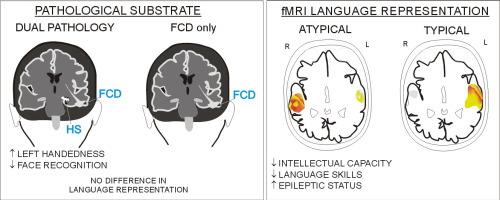Atypical language representation in children with intractable temporal lobe epilepsy |
| |
| Affiliation: | 1. Charles University, Faculty of Arts, Department of Psychology, Prague, Czech Republic;2. Motol University Hospital, Prague, Czech Republic;3. Brain Institute, Nicklaus Children''s Hospital, Miami, FL, United States;4. Department of Neurology, University of Miami Miller School of Medicine, Miami, FL, United States;5. Department of Radiology, Nicklaus Children''s Hospital, Miami, FL, United States;6. Charles University, 2nd Faculty of Medicine, Prague, Czech Republic;7. University of Ostrava, Faculty of Medicine, Ostrava, Czech Republic;8. Faculty Hospital Ostrava, Ostrava, Czech Republic;1. Faculty of Psychology and Education Sciences — University of Coimbra, Coimbra, Portugal;2. Instituto de Biofísica e Engenharia Biomédica, Faculdade de Ciências, Universidade de Lisboa, Portugal;3. Department of Physics — Faculty of Sciences and Technologies, New University of Lisbon, Caparica, Portugal;4. Ressonância Magnética — Caselas, Lisboa, Portugal;5. Department of Neurophysiology, Centro Hospitalar Psiquiátrico de Lisboa, Lisbon, Portugal;1. Department of Medical and Surgical Sciences, Magna Graecia University, Viale Europa, Catanzaro, Italy;2. Regional Epilepsy Center, Bianchi-Melacrino-Morelli Hospital, Via Melacrino, Reggio Calabria, Italy;3. Clinical Epileptology and Experimental Neurophysiology Unit, Fondazione I.R.C.C.S. Istituto Neurologico “C. Besta”, Via Celoria 11, Milan, Italy |
| |
| Abstract: | 
This study evaluated language organization in children with intractable epilepsy caused by temporal lobe focal cortical dysplasia (FCD) alone or dual pathology (temporal lobe FCD and hippocampal sclerosis, HS). We analyzed clinical, neurological, fMRI, neuropsychological, and histopathologic data in 46 pediatric patients with temporal lobe lesions who underwent excisional epilepsy surgery. The frequency of atypical language representation was similar in both groups, but children with dual pathology were more likely to be left-handed. Atypical receptive language cortex correlated with lower intellectual capacity, verbal abstract conceptualization, receptive language abilities, verbal working memory, and a history of status epilepticus but did not correlate with higher seizure frequency or early seizure onset. Histopathologic substrate had only a minor influence on neuropsychological status. Greater verbal comprehension deficits were noted in children with atypical receptive language representation, a risk factor for cognitive morbidity. |
| |
| Keywords: | |
| 本文献已被 ScienceDirect 等数据库收录! |
|

